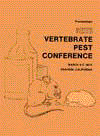Vertebrate Pest Conference Proceedings collection
Date of this Version
March 1974
Document Type
Article
Abstract
Vector-borne disease prevention and control strategies, aside from those associated with domestic rodents, have rarely involved management of vertebrate populations, even though in many cases such management would appear to represent the most effective and economical long-term approach. Prevention of a long list of arthropod transmitted diseases is often at best a stop-gap procedure undertaken only after substantial disease hazard is detected in reservoir populations. More often, control actions await the detection of human cases, at which time short-term emergency control measures may be conducted, usually involving the use of toxicants against arthropod vectors and occasionally vertebrate reservoirs. In some cases, action is not taken because techniques are not available, but more often the decisive factors in action versus inaction are economic, jurisdictional, and/or organizational. Often, public health problems proceeding from unmanaged vertebrate populations are (justifiably) given low priority on the basis of costs versus benefits. If the same populations constitute a problem for health, economic, wildlife , or recreational interests, it may behoove us to pool our priorities, skills, and resources in collaborative management program designed for the greatest overall benefit rather than to proceed only on those programs that can be justified on the basis of one special interest.

